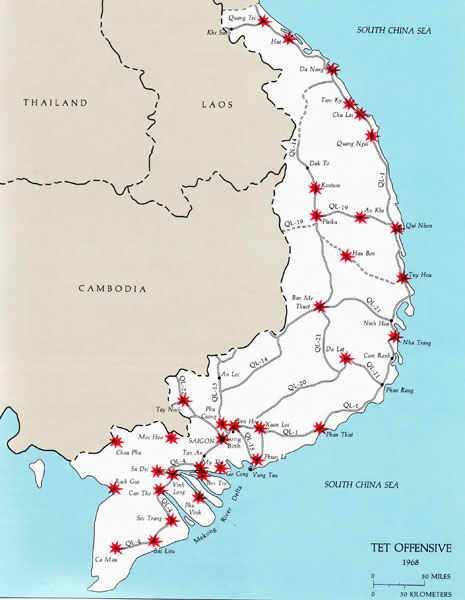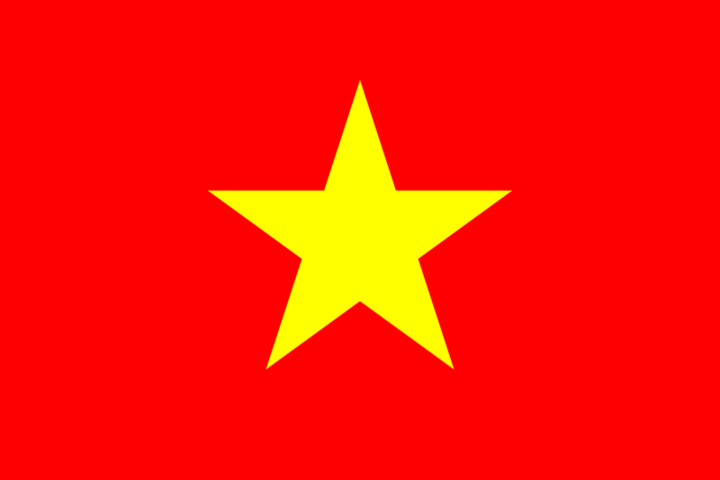 |
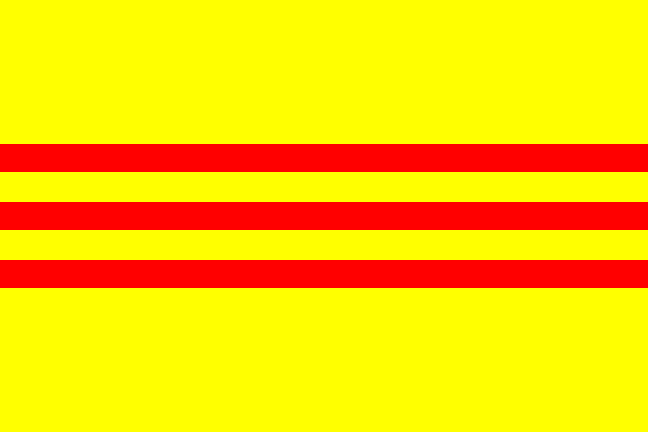 |
Assignment Topic
| How did the Tet Offensive influence society, politics, and military policy in the United States?
|
| Back to Top
|
Overview
The
Vietnam War was fought between the Communist North Vietnamese and the
Democratic South Vietnamese. Originally, a French controlled
colony, Vietnam gained its independence after the battle of Battle of
Dien Bien Phu in 1954. The 17th parallel with a demilitarized
zone (DMZ) between had divided Vietnam in 1954 with the Geneva Accords.
The North Vietnamese Army (NVA) and the Vietcong used guerrilla warfare
and pitched battles to drive into South Vietnam. The South
Vietnamese army, known as the Army of the Republic of Vietnam (ARVN),
and the U.S. military protected South Vietnam while driving into North
Vietnam, Laos and Cambodia. The U.S. aided the Democratic South
Vietnamese with supplies and military advisors in the beginning of the
conflict. It was not until the Gulf of Tonkin Incident that the
U.S. was able to use military force in any means other than an advisory
one. At the height of the war over half a million servicemen were
active in that theatre of war. The U.S. goal of the war was to contain
the spread of Communism in accordance with the Domino Theory
foreign policy.
|
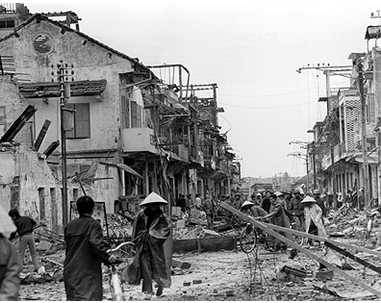 |
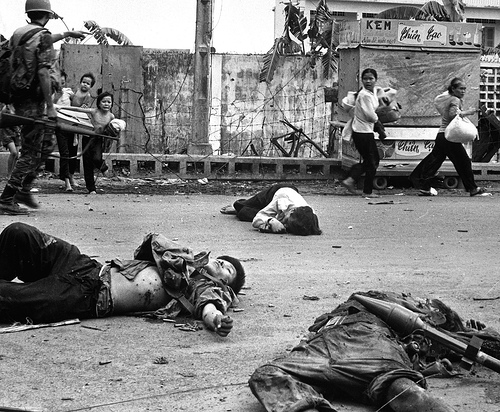
|
At the beginning
of the war between North and South Vietnam, the U.S. mainly
provided supplies and military advisers. In 1964, an unprovoked
attack on naval destroyers in U.S. recognized international
waters at the Gulf of Tonkin caused the Gulf of Tonkin Resolution
to be passed by Congress. This resolution gave the U.S. president,
Lyndon Johnson, the ability to use military forces in Vietnam
without formally declaring war. In 1968, the military command of North Vietnam planned a campaign that was to try to end the
war in a single blow. The campaign comprised of elements of
the NVA and Vietcong to strike military and civilian centers
throughout the South. At the same time, the NVA and Vietcong
were to help and engage an uprising with the civilian population
of South Vietnam. On January 31st, while under a ceasefire agreement
during the Tet Holiday (Spring Festival), NVA and Vietcong troops
struck over a 100 towns and cities. This complex and coordinated series
of attacks became known as the Tet Offensive in the U.S. and the General Offensive
and Uprising in Vietnam. |
Initially
the U.S. troops and the ARVN were surprised and pushed back,
but were able to regroup and counter attack in short order.
The social uprising fared little better than the military assault,
except to bring more numbers and safe havens to the Vietcong.
During the multiple phases of the Tet Offensive, the Communist
forces and Vietcong lost over 85,000 troops.
U.S. citizens and the media looked at the Tet offensive from a different point
of view. While it was a disaster for the North Vietnamese and
the majority of military objectives lay uncompleted, it was
a blow to the morale and resolve of the U.S. and South Vietnamese.
Shortly after the Tet Offensive, proposed peace talks began
in Paris as well as the beginning of the withdrawal of U.S.
military forces from South Vietnam. Within just a few years,
almost all of the U.S servicemen in South Vietnam have been
withdrawn, and only the ARVN is left to withstand the NVA and
Vietcong. In 1975, South Vietnam surrenders to the North Vietnamese
and the remaining U.S. personnel and South Vietnamese refugees
were airlifted from the U.S. embassy in Saigon. |
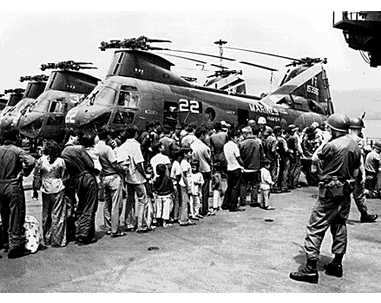
|
Watch some
Tet Offensive video at EncycloMedia.com.
Back to Top |
Chronology
- 1945 - Ho Chi Minh declares independence for Vietnam.
- 1950 - First U.S. military advisory sent to advise French
in Vietnam.
- 1953 - Dien Bien Phu occupied by the French Army.
- 1954 - Viet Minh defeat French army at Dien Bien Phu. 17th
Parallel divides Vietnam (DMZ), two governments are formed the North
Vietnamese communist government and the South's Republic of Vietnam
(RVN).
- 1959 - Communist supporters in South Vietnam working in
conjunction with communists in North Vietnam create the Ho Chi Minh
Trail to support troops and transfer supplies.
- 1960 - Communists form National Liberation Front in South
also known as the Viet Cong.
- 1961 - Kennedy becomes 35th President of the US, and promptly
increases economic and military support to the RVN.
- 1962 - Military Assistance Command Vietnam (MACV) established
in South Vietnam at Saigon.
- 1963 - U.S aids in the coup that kills Ngo Dinh Diem, and
troop strength reachs 16,000 servicemen. (Nov. 1).
- 1964 - North Vietnamese torpedo boats attack U.S. naval
vessels in international waters at the Gulf of Tonkin. Gulf of Tonkin
resolution passed by Congress.
- 1965 - Operation Rolling Thunder proceeds with sustained
bombing missions. First U.S. Combat troops arrive.
- 1966 - U.S. forces reach 385,000 servicemen, Operation
Crimp largest U.S. operation of the war to capture the Vietcong's
headquarters for the Saigon area, but fails to find it.
- 1967 - South Vietnam National Assembly elects Nguyen Van
Thieu as president, U.S. troop strength level reaches 485,600 servicemen.
- 1968 - During the Tet offensive, Viet Cong guerrillas attack
Saigon, Hue, trying to incite South Vietnamese to join them . Peace
talks begin in Paris.
- 1969 - U.S. troop strength reaches high at 536,100 servicemen,
President Nixon makes peace offer, North Vietnamese forms Provisional
Revolutionary Government. Large demonstrations in U.S. protest war.
- 1970 - U.S. begins missions into Cambodia. Shootings at
Kent State demonstration.
- 1971 - ARVN troops, along with U.S. air forces, defeated
in Laos thrust. Troop strength decreasing as more troops are sent
home.
- 1972 - North Vietnamese drive across DMZ capture major
cities and provinces in South Vietnam. President Nixon orders new
bombing missions of Hanoi-Haiphong area.
- 1973 - President Nixon orders end to all offensive operations
in North Vietnam. Cease fire signed in Paris.
- 1974 - Both sides bring accusations of violations of the
cease-fire signed in Paris. South Vietnamese forces pushed back
due to lack of training, supplies, and support.
- 1975 - Full-scale warfare resumes in blatant disregard
of the peace treaty with no U.S response. South Vietnamese government
surrenders to North Vietnam. Remaining civilians and refugees airlifted
out.
Back to Top
|
Websites
- An indepth website dealing with the Tet Offensive and it's aftermath,
including pictures and a recount of the 30th anniversary of the
Tet Offensive is Vets
With A Mission.
- A breakdown of the Tet Offensive, key players, battles, and analysis
is Wikipedia:
The Tet Offensive.
- An interesting news article from a different point of view about the General Offensive and Uprising can be found here.
- Interviews, TV broadcasts, and articles dealing with the Tet Offensive
and other Vietnam related items from NPR.
- A look at the Tet Offensive from the point of view of the Military Police who fought in it.
- www.u-s-history.com
is a travel and history site that gives a good review of the Tet
Offensive with additional material for the Vietnam War as well.
- Mahalo has a very comprehensive list of research links, blogs, and a good timeline.
Some general information sites:
- A website that has a collection of anything related to the Vietnam
war from white papers to videos is The
Vietnam Center and Archive.
- A good overview of the Vietnam War with a chronolgy, and military
breakdown of the war is PBS
sponsored :Battlefield Vietnam.
- For many different multimedia materials to use, History.com is an excellent source to research different aspects of the Vietnam War.
Bibliographies of some key players:
Back to Top
|
Related Readings
- A book that focuses on the effects of the Tet Offensive on U.S.
Policy and U.S. civilian populations is The Tet Offensive: A
Concise History. by James Willibanks (Columbia University Press).
- Another excellent source of material was Tet!: The Turning Point
in the Vietnam War by Don Oberdorfer (JHU Press). This book
took a look at the thoughts of leaders from both sides, and the
political causes and effects of the Tet Offensive.
- For a look at the point of view of the media and it's role in
the effects and after effects of the Tet offensive read Big Story:
How the American Press and Television Reported and Interpreted the
Crisis of Tet 1968 in Washington and Vietnam by Peter Braestrup
(Yale University Press).
- A fantastic book about the Vietnam war for general knowledge is
Vietnam: A History by Stanley Karnow (Penguin.)
- For a great reference tool for anything dealing with the Vietnam
war read The Vietnam War Almanac by John Bowman (Barnes and Noble).
Back to Top
HIS
135 home page
|
|


